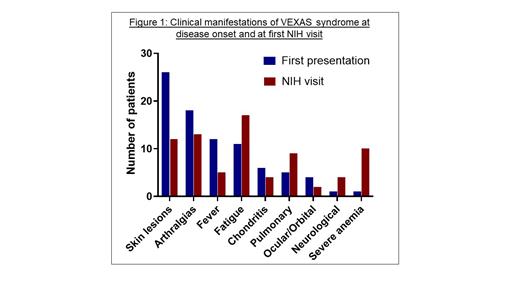Introduction
Vacuoles, E1 enzyme, X-linked, autoinflammatory, somatic (VEXAS) syndrome is caused by somatic mutations in UBA1 and characterized by systemic autoinflammation and hematologic manifestations. Clinically, disease progression appears heterogenous, with differing degrees of organ involvement seen in individual patients over time. Disease mortality is high, and to date only UBA1 variant, presence of MDS or significant cytopenia, and clonal hematopoiesis have been associated with worse overall survival. Prospective data are currently lacking on evolution of symptoms and organ involvement. We characterized disease evolution over time and looked at the benefit of prescribed therapies in our prospective cohort of VEXAS patients.
Methods
Forty-four VEXAS patients with a confirmed UBA1 mutation have been enrolled in our study at the National Institutes of Health (NIH) since 2019. We collected demographic data and clinical history, and performed standardized evaluations including peripheral blood counts, inflammatory markers, serum protein electrophoresis, and bone marrow biopsies. All patients were screened for eligibility and suitability for hematopoietic stem cell transplant (HSCT) on a phase II clinical trial (NCT05027945). Patients who did not undergo HSCT received recommendations for medical therapy.
Results
Subjects were male with median age of 67 years (50 - 79) and 95% were of White ethnicity. The most common UBA1 variant was M41T (n=19, 43%) followed by M41L (n=15, 34%), M41V (n=7, 16%), and splice motif mutations (n=4, 7%). Median variant allele fraction (VAF) of the cohort was 73%; M41T (76%), M41L (70%), M41V (58%), splice (61%). Thirty-six (82%) patients initially presented with skin lesions and/or arthralgias. Other initial manifestations included fever (27%), fatigue (25%), chondritis (14%), pulmonary (11%) and ocular/orbital (9%). Interestingly, only one patient presented with symptomatic anemia.
At the time of first NIH clinic visit patients had manifestations of VEXAS disease for median of 6 years (range 1 - 11). Only 20% (9/44) had no active symptoms. Fatigue (39%) was most common followed by skin rash, arthralgias, pulmonary, and neurologic manifestations (Figure). Twenty-three percent had developed transfusion dependent anemia. Eleven patients (25%) had bone marrow findings meeting criteria for myelodysplastic syndrome (MDS); one patient had MDS-EB1. Venous thromboembolism was documented in 18 patients (40%). Thirteen patients (30%) had plasma cell disorder, four of whom had multiple myeloma (MM).
All except one patient were receiving prednisone at NIH evaluation, with median dose of 20mg (range 5mg-50mg). Sixteen patients (36%) had elevated CRP despite glucocorticoids and steroid-sparing agents. In 66% of patients, concomitant steroid-sparing agents were used, most frequently IL-6 inhibitors (n=9), or JAK inhibitors (n=6). Other agents included erythropoietin stimulating agents (n=2), canakinumab (n=2), adalimumab (n=2), methotrexate (n=2), and azacytidine, azathioprine, colchicine, dapsone, ustekinumab in one patient each. Two patients were on MM directed therapies.
At last follow-up, 8 patients (18%) had died, 6 patients (14%) were post HSCT, and 9 patients (20%) were pursuing HSCT. The indication for HSCT was refractory inflammation in two patients and progressive marrow failure in four. Twenty-one patients continued medical management: 15 (35%) with controlled inflammation on their respective regimens and 6 (14%) with progressive hemato-inflammatory manifestations. Of these six patients, one was non-compliant with therapy other than prednisone and other five were deemed unfit for HSCT due to poor performance status (n=2), age (n=2), or kidney disease (n=1).
Conclusion
Clinical manifestations of VEXAS syndrome evolve and progress with time. Severe cytopenia is rare at disease onset. Our observations indicate that biologics directed at JAK-STAT pathway, IL-6, IL-1 and hypomethylating agents may provide qualitative benefit in one-third of cases evidenced by controlled disease, but are not steroid sparing. HSCT is a curative approach, but, the timing is not well established. Most challenging are patients who have exhausted all effective steroid-sparing agents, require high dose of glucocorticoids, and are not a HSCT candidate. Development of effective therapies for VEXAS is a research priority to improve outcomes.
Disclosures
No relevant conflicts of interest to declare.


This feature is available to Subscribers Only
Sign In or Create an Account Close Modal